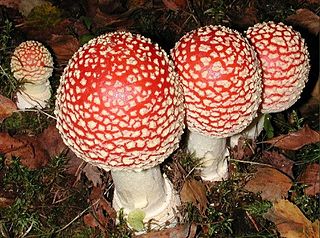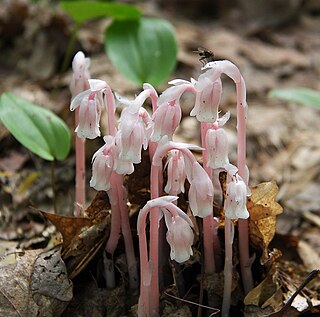Related Research Articles

A mycorrhiza is a symbiotic association between a fungus and a plant. The term mycorrhiza refers to the role of the fungus in the plant's rhizosphere,the plant root system and its surroundings. Mycorrhizae play important roles in plant nutrition,soil biology,and soil chemistry.

A truffle is the fruiting body of a subterranean ascomycete fungus,one of the species of the genus Tuber. More than one hundred other genera of fungi are classified as truffles including Geopora,Peziza,Choiromyces,and Leucangium. These genera belong to the class Pezizomycetes and the Pezizales order. Several truffle-like basidiomycetes are excluded from Pezizales,including Rhizopogon and Glomus. Truffles are ectomycorrhizal fungi,so they are found in close association with tree roots. Spore dispersal is accomplished through fungivores,animals that eat fungi. These fungi have ecological roles in nutrient cycling and drought tolerance.

An arbuscular mycorrhiza (AM) is a type of mycorrhiza in which the symbiont fungus penetrates the cortical cells of the roots of a vascular plant forming arbuscules. Arbuscular mycorrhiza is a type of endomycorrhiza along with ericoid mycorrhiza and orchid mycorrhiza. They are characterized by the formation of unique tree-like structures,the arbuscules. In addition,globular storage structures called vesicles are often encountered.

Celastrus orbiculatus is a woody vine of the family Celastraceae. It is commonly called Oriental bittersweet,as well as Chinese bittersweet,Asian bittersweet,round-leaved bittersweet,and Asiatic bittersweet.

Myco-heterotrophy is a symbiotic relationship between certain kinds of plants and fungi,in which the plant gets all or part of its food from parasitism upon fungi rather than from photosynthesis. A myco-heterotroph is the parasitic plant partner in this relationship. Myco-heterotrophy is considered a kind of cheating relationship and myco-heterotrophs are sometimes informally referred to as "mycorrhizal cheaters". This relationship is sometimes referred to as mycotrophy,though this term is also used for plants that engage in mutualistic mycorrhizal relationships.

Revegetation is the process of replanting and rebuilding the soil of disturbed land. This may be a natural process produced by plant colonization and succession,manmade rewilding projects,accelerated process designed to repair damage to a landscape due to wildfire,mining,flood,or other cause. Originally the process was simply one of applying seed and fertilizer to disturbed lands,usually grasses or clover. The fibrous root network of grasses is useful for short-term erosion control,particularly on sloping ground. Establishing long-term plant communities requires forethought as to appropriate species for the climate,size of stock required,and impact of replanted vegetation on local fauna. The motivations behind revegetation are diverse,answering needs that are both technical and aesthetic,but it is usually erosion prevention that is the primary reason. Revegetation helps prevent soil erosion,enhances the ability of the soil to absorb more water in significant rain events,and in conjunction reduces turbidity dramatically in adjoining bodies of water. Revegetation also aids protection of engineered grades and other earthworks.

The Rocky Mountain Biological Laboratory is a high-altitude biological field station located near Crested Butte,in the abandoned mining town of Gothic,Colorado in the West Elk Mountains. The laboratory was founded in 1928. Research areas include the ecology of the region,climate change,pollination biology,and a long-running study of the yellow-bellied marmot. The laboratory offers courses for undergraduate students,including National Science Foundation-funded REU students,and provides support for researchers from universities and colleges.

A mycorrhizal network is an underground network found in forests and other plant communities,created by the hyphae of mycorrhizal fungi joining with plant roots. This network connects individual plants together. Mycorrhizal relationships are most commonly mutualistic,with both partners benefiting,but can be commensal or parasitic,and a single partnership may change between any of the three types of symbiosis at different times.

The root microbiome is the dynamic community of microorganisms associated with plant roots. Because they are rich in a variety of carbon compounds,plant roots provide unique environments for a diverse assemblage of soil microorganisms,including bacteria,fungi,and archaea. The microbial communities inside the root and in the rhizosphere are distinct from each other,and from the microbial communities of bulk soil,although there is some overlap in species composition.
Orchid mycorrhizae are endomycorrhizal fungi which develop symbiotic relationships with the roots and seeds of plants of the family Orchidaceae. Nearly all orchids are myco-heterotrophic at some point in their life cycle. Orchid mycorrhizae are critically important during orchid germination,as an orchid seed has virtually no energy reserve and obtains its carbon from the fungal symbiont.

Meghan Anne Duffy is an American biologist and the Susan S. Kilham Collegiate Professor of Ecology and Evolutionary Biology at the University of Michigan. She focuses on the causes and consequences of parasitism in natural populations of lake populations. In 2019,she created a task force to examine factors that influence the mental health and well-being of graduate students at the University of Michigan.
Pamela H. Templer is an ecosystem ecologist and professor at Boston University who focuses on plant-microbial interaction and their effect on carbon exchange and nutrient cycling. She is also interested in examining how urban ecosystems function,how human actions influence nutrient cycling,atmosphere-biosphere interactions,and other ecosystem processes.
Christine Goodale is an ecosystem ecologist and an Associate Professor in the Department of Ecology and Evolutionary Biology at Cornell University. Goodale conducts research that studies the cycling of water,carbon,nitrogen and other nutrients through forest ecosystems.
Kathryn Linn Cottingham is a Professor of Ecology,Evolution,Environment and Society in the John Sloan Dickey Center for International Understanding at Dartmouth College. She is a Fellow of the Ecological Society of America and American Association for the Advancement of Science. From 2020 she will serve as editor-in-chief of the journal Ecology.
Victoria Louise Sork is an American scientist who is Professor and Dean of Life Sciences at University of California,Los Angeles. She studies tree populations in California and the Eastern United States using genomics,evolutionary biology and conservation biology. Sork is a Fellow of the American Association for the Advancement of Science.
Andia Chaves Fonnegra is a Colombian marine biologist known for her research on the marine sponge Cliona delitrix.
Dr. Elizabeth Derryberry is an associate professor specializing in ornithology,in the Department of Ecology and Environmental Biology in the College of Arts and Sciences at the University of Tennessee.
Nancy Collins Johnson is an American earth scientist who is the Regents’Professor and Director of the School of Earth Sciences &Environmental Sustainability at Northern Arizona University. Her work considers soil microbial ecology and the study of mycorrhizal fungi. She was elected a Fellow of the American Association for the Advancement of Science in 2020.
The International Collection of (Vesicular) Arbuscular Mycorrhizal Fungi (INVAM) is the largest collection of living arbuscular mycorrhizal fungi (AMF) and includes Glomeromycotan species from 6 continents. Curators of INVAM acquire,grow,identify,and elucidate the biology,taxonomy,and ecology of a diversity AMF with the mission to expand availability and knowledge of these symbiotic fungi. Culturing AMF presents difficulty as these fungi are obligate biotrophs that must complete their life cycle while in association with their plant hosts,while resting spores outside of the host are vulnerable to predation and degradation. Curators of INVAM have thus developed methods to overcome these challenges to increase the availability of AMF spores. The inception of this living collection of germplasm occurred in the 1980s and it takes the form of fungi growing in association with plant symbionts in the greenhouse,with spores preserved in cold storage within their associated rhizosphere. AMF spores acquired from INVAM have been used extensively in both basic and applied research projects in the fields of ecology,evolutionary biology,agroecology,and in restoration. INVAM is umbrellaed under the Kansas Biological Survey at The University of Kansas,an R1 Research Institution. The Kansas Biological Survey is also home to the well-known organization Monarch Watch. INVAM is currently located within the tallgrass prairie ecoregion,and many collaborators and researchers associated with INVAM study the role of AMF in the mediation of prairie biodiversity. James Bever and Peggy Schultz are the Curator and Director of Operation team,with Elizabeth Koziol and Terra Lubin as Associate Curators.

Judith Lee Bronstein is an American ecologist and evolutionary biologist who researches mutualisms,or positive species interactions. She has edited multiple books and volumes,including Mutualism,which was published by Oxford University Press in 2016.
References
- 1 2 3 4 5 6 7 Barath, Harini (2022-06-06). "Putting Soil Under the Microscope". Dartmouth News. Retrieved 2024-06-27.
- 1 2 Albright, Charlotte (2022-12-09). "Widening Doorways to STEM Education". Guarini School of Graduate and Advanced Studies. Retrieved 2024-07-01.
- 1 2 3 4 5 6 7 8 9 "Women in Ecology – Bala Chaudhary". National Ecological Observatory Network | NSF. 2021-05-05. Retrieved 2024-07-01.
- 1 2 3 4 5 6 Hughes, Carol (2019-04-25). "BALA CHAUDHARY RECEIVES NSF CAREER GRANT TO STUDY DISPERSAL OF MYCORRHIZAL FUNGI". DePaul Newsline. Retrieved 2024-07-01.
- 1 2 "The Answers (to Fungal Spore Dispersal) Are Blowing in the Wind". National Ecological Observatory Network. 2020-09-02. Retrieved 2024-07-01.
- 1 2 Venton, Danielle (2020-07-13). "Ten Simple Rules for Building an Anti-Racist Research Lab". KQED. Retrieved 2024-07-01.
- 1 2 Rockett, Darcel (2020-10-23). "How to build an anti-racist STEM lab: Tips from a DePaul University scientist". Chicago Tribune. Retrieved 2024-07-08.
- 1 2 "Empowering Women Scientists of Color". Association of American Universities. 2023-07-26. Retrieved 2024-06-28.
- 1 2 Olson, Amy (2022-03-17). "How a Name Change Can Impact a Female Researcher's Career". Dartmouth News. Retrieved 2024-07-01.